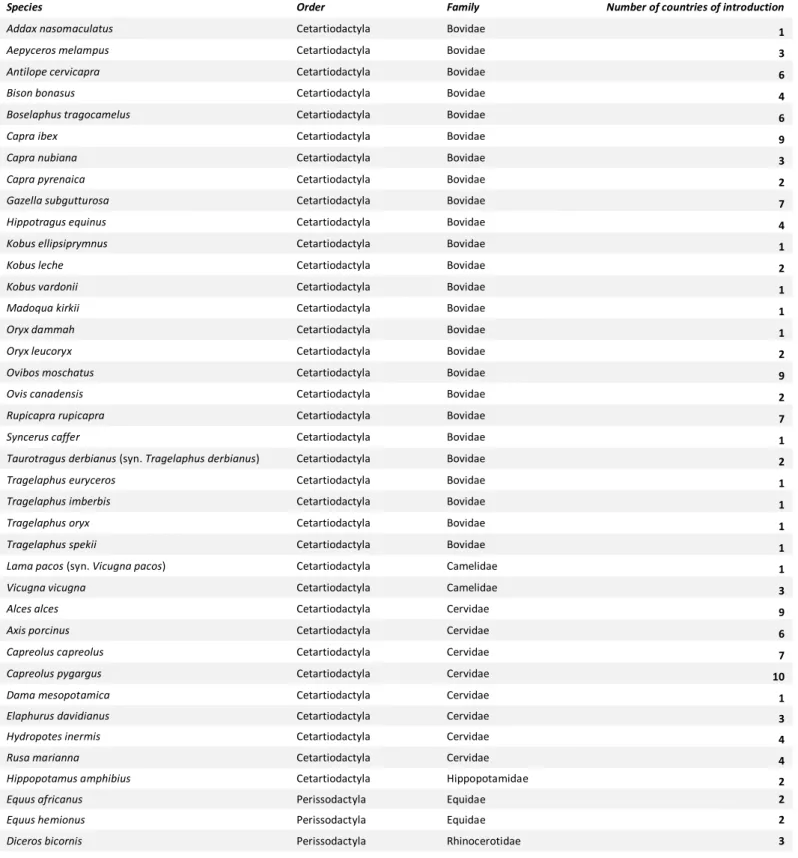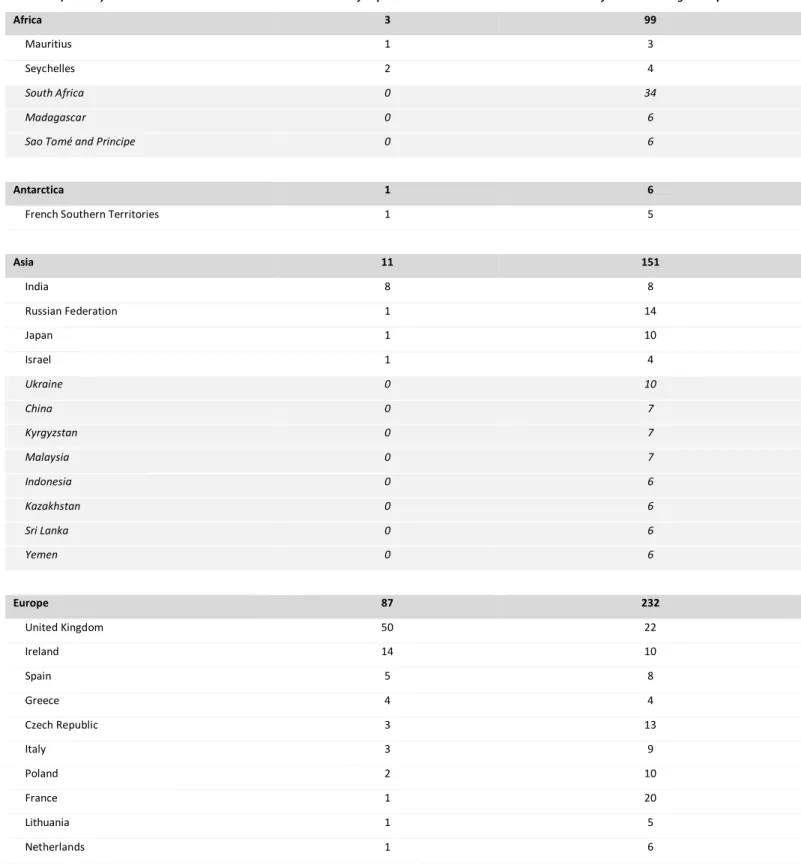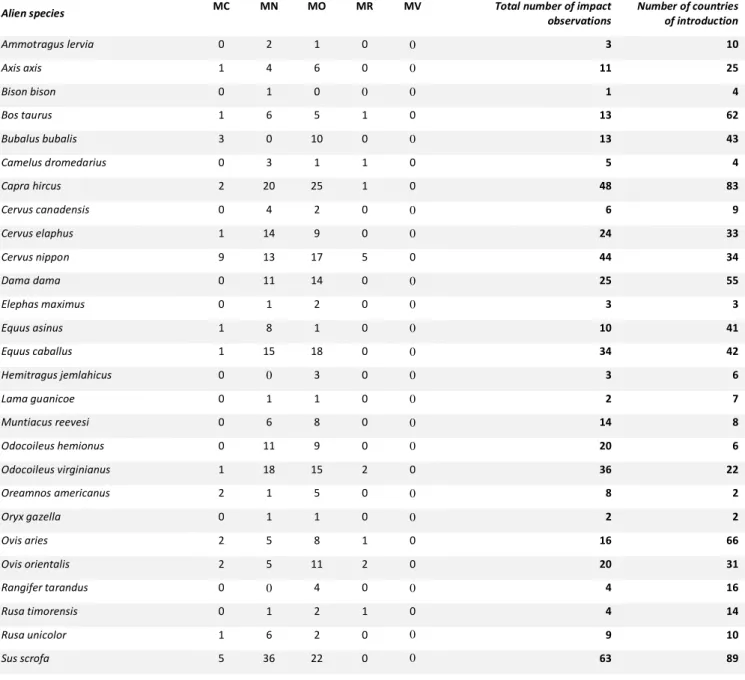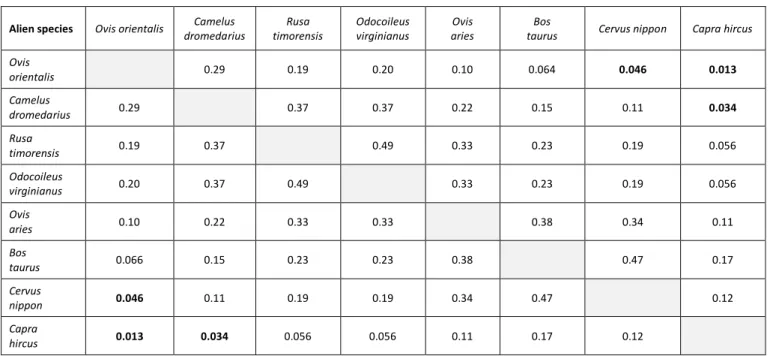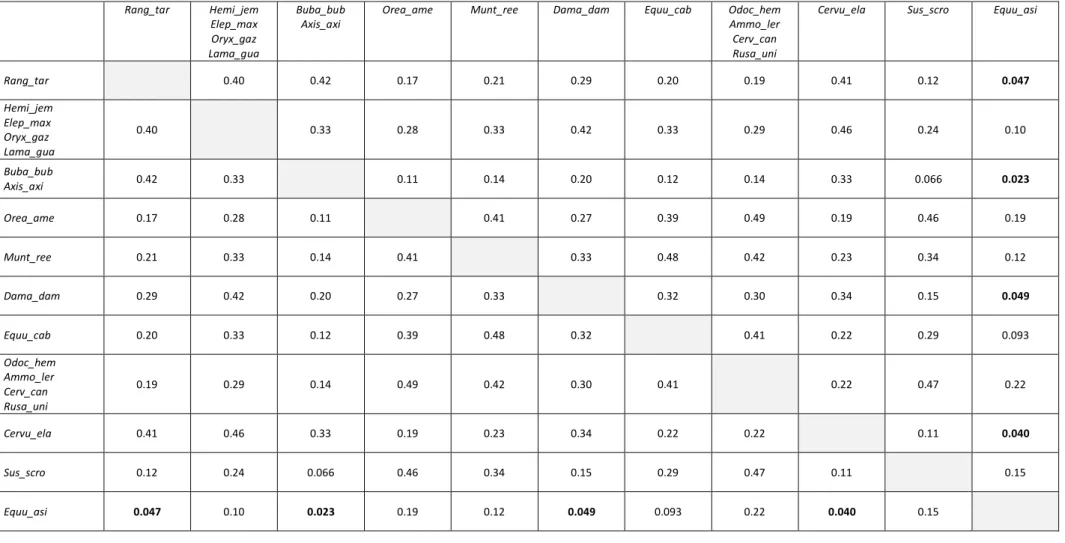a. Additional information about the EICAT assessment procedure
Uncertainty rationales
Confidence levels (high, medium or low) are assigned to each observation to indicate how confident the assessor is that the assigned magnitude is the ‘true’ one: the assessor therefore evaluates the chances that the ‘true’ impact magnitude is different from the one assigned (IUCN, 2020b; Volery et al., 2020). A High confidence level is assigned to an impact observation only when the assessor is confident that the assigned magnitude is the true one, i.e. that higher or lower impact magnitudes are unlikely according to the impact description and methodology of the study. A Medium confidence level is assigned when evidence indicates that the true impact magnitude is likely to be the one assigned, but that be a higher or lower magnitude is also possible. When the assessor did not find evidence indicating that the true impact magnitude is likely to be the assigned one, a Low confidence level was assigned. A Low confidence level can be assigned to vague impact observations with few or no details on the experimental or observational set-up, but also to well-designed studies testing effects not easily transferrable into EICAT criteria.
In our study, to increase transparency on how the confidence levels were assigned and to highlight where uncertainty occurs in each observation, the assessor evaluated if the true impact could be higher or lower than the one described, based on the described impact in the report and considering the methodology for observing it (see Sheet 4 in Supp. 2).
For example, if a field study finds decreases in performance of individuals of a native species (observed impact = MN), but did not look at changes in its population density, it is possible that the true impact might even have led to a population decrease (MO) (IUCN, 2020b; Probert et al., 2020; Volery et al., 2020). It is however unlikely that the impact is negligible (MC) as the decrease in the performance of native individuals was observed; it is also unlikely that the alien led to a local extinction (MR/MV) as individuals were observed. This approach led to higher consistency among the three assessors.
Species guilds
Deer are often forming guilds of several species, making it difficult to evaluate the impact of a species independently
from the others (e.g. Wardle, Barker, Yeates, Bonner, & Ghani, 2001). When the experimental set-up did not allow
distinguishing the individual impacts of each species, we assigned the described impact to all alien species in the guild
and decreased the confidence level. For instance, if a species was the most abundant in the guild, it is likely that this
species was contributing to the described impacts (no decrease in the confidence level), whereas if a species comprised
only a small part of the guild, it is less clear whether it contributed to the described impact or whether the same impact
would have been occurring in its absence (decrease in confidence level).
Complementary studies
In a few cases where multiple studies where explicitly complementing each other, the assessor combined them into one
impact observation (see Sheet 4 in Supp. 2). For instance, one study was observing the change in the native population
(e.g. a decline in the population size), and another study was establishing the link between this change and the alien
(e.g. by showing the mechanism through which the alien is acting on the native population). This was to avoid double
counting of impacts. When the link between two studies was not explicitly made in the reports, we did not combine
studies.
b. R code for the significance test of pairwise comparisons between impact risks To compare the impact risk of Species
awith the impact risk of Species
b:
# Generating beta distributions for Species
aand Species
b, based on the frequency at which they caused their highest impact a <- rbeta(number_of_simulations, (Species
a_number_of_successes + 1), (Species
a_number_of_failures + 1)) (where “successes”
indicate the number of regions in which Species
acaused its highest impact magnitudes, and “failures” indicate the number of regions in which it caused lower impacts)
b <- rbeta(number_of_simulations, (Species
b_number_of_successes + 1), (Species
b_number_of_failures + 1))
# Comparing the two distributions by calculating their overlap sum((a-b)>0)/number_of_simulations
sum((b-a)>0)/number_of_simulations
We used 100’000 simulations to generate random beta distributions. The lowest overlap measure is taken as the p-
value: values around 0.5 indicate a complete overlap of the two probability distributions, whereas values around 0
indicate almost no overlap and allow to reject the null hypothesis that the two probability distributions are not different.
Table S1. Species classified as Data Deficient (DD). To test whether more widely ungulates were more often studied (see Table S8), we added the numbers of countries each species has been introduced to (no re-introductions) (extracted from Sheet 3 in Supp. 2).
Species Order Family Number of countries of introduction
Addax nasomaculatus Cetartiodactyla Bovidae 1
Aepyceros melampus Cetartiodactyla Bovidae 3
Antilope cervicapra Cetartiodactyla Bovidae 6
Bison bonasus Cetartiodactyla Bovidae 4
Boselaphus tragocamelus Cetartiodactyla Bovidae 6
Capra ibex Cetartiodactyla Bovidae 9
Capra nubiana Cetartiodactyla Bovidae 3
Capra pyrenaica Cetartiodactyla Bovidae 2
Gazella subgutturosa Cetartiodactyla Bovidae 7
Hippotragus equinus Cetartiodactyla Bovidae 4
Kobus ellipsiprymnus Cetartiodactyla Bovidae 1
Kobus leche Cetartiodactyla Bovidae 2
Kobus vardonii Cetartiodactyla Bovidae 1
Madoqua kirkii Cetartiodactyla Bovidae 1
Oryx dammah Cetartiodactyla Bovidae 1
Oryx leucoryx Cetartiodactyla Bovidae 2
Ovibos moschatus Cetartiodactyla Bovidae 9
Ovis canadensis Cetartiodactyla Bovidae 2
Rupicapra rupicapra Cetartiodactyla Bovidae 7
Syncerus caffer Cetartiodactyla Bovidae 1
Taurotragus derbianus (syn. Tragelaphus derbianus) Cetartiodactyla Bovidae 2
Tragelaphus euryceros Cetartiodactyla Bovidae 1
Tragelaphus imberbis Cetartiodactyla Bovidae 1
Tragelaphus oryx Cetartiodactyla Bovidae 1
Tragelaphus spekii Cetartiodactyla Bovidae 1
Lama pacos (syn. Vicugna pacos) Cetartiodactyla Camelidae 1
Vicugna vicugna Cetartiodactyla Camelidae 3
Alces alces Cetartiodactyla Cervidae 9
Axis porcinus Cetartiodactyla Cervidae 6
Capreolus capreolus Cetartiodactyla Cervidae 7
Capreolus pygargus Cetartiodactyla Cervidae 10
Dama mesopotamica Cetartiodactyla Cervidae 1
Elaphurus davidianus Cetartiodactyla Cervidae 3
Hydropotes inermis Cetartiodactyla Cervidae 4
Rusa marianna Cetartiodactyla Cervidae 4
Hippopotamus amphibius Cetartiodactyla Hippopotamidae 2
Equus africanus Perissodactyla Equidae 2
Equus hemionus Perissodactyla Equidae 2
Diceros bicornis Perissodactyla Rhinocerotidae 3
Table S2. Locations of impact observations. We list the 34 countries for which impact observations were available (white lines). To test whether impacts of ungulates were more often studied in countries with more introduced ungulate species (see Table S11), we added the numbers of introduced ungulate species per country (no re-introductions; extracted from Sheet 3 in Supp. 2). We completed the list with countries without impact observation, but with > 6 introduced ungulate species (grey lines and italic).
Continent/Country Number of impact observations Number of introduced ungulate species
Africa 3 99
Mauritius 1 3
Seychelles 2 4
South Africa 0 34
Madagascar 0 6
Sao Tomé and Principe 0 6
Antarctica 1 6
French Southern Territories 1 5
Asia 11 151
India 8 8
Russian Federation 1 14
Japan 1 10
Israel 1 4
Ukraine 0 10
China 0 7
Kyrgyzstan 0 7
Malaysia 0 7
Indonesia 0 6
Kazakhstan 0 6
Sri Lanka 0 6
Yemen 0 6
Europe 87 232
United Kingdom 50 22
Ireland 14 10
Spain 5 8
Greece 4 4
Czech Republic 3 13
Italy 3 9
Poland 2 10
France 1 20
Lithuania 1 5
Netherlands 1 6
Portugal 1 7
Germany 0 15
Sweden 0 10
Austria 0 8
Belgium 0 7
Slovakia 0 7
Denmark 0 6
Finland 0 6
Latvia 0 6
Slovenia 0 6
Switzerland 0 6
North and Central America 170 159
United States 119 33
Canada 41 16
Mexico 9 14
Saint Pierre and Miquelon 3 1
Saint Vincent and the Grenadines 1 1
Cuba 0 12
Antigua and Barbuda 0 7
Grenada 0 6
Haiti 0 6
Saint Kitts and Nevis 0 6
Oceania 123 110
New Zealand 61 18
Australia 49 21
Northern Mariana Islands 7 5
Fiji 3 5
New Caledonia 2 6
Papua New Guinea 1 11
Vanuatu 0 6
South America 47 104
Argentina 23 23
Ecuador 14 8
Brazil 6 9
Chile 2 10
Falkland Islands 2 6
Colombia 0 11
Peru 0 10
Bolivia 0 6
Venezuela 0 6
Table S3. Distribution of impact magnitudes per species. To test whether more widely introduced ungulates were more often studied (see Table S8), we added the numbers of countries each species has been introduced to (no re- introductions) (extracted from Sheet 3 in Supp. 2).
Alien species MC MN MO MR MV Total number of impact
observations
Number of countries of introduction
Ammotragus lervia 0 2 1 0 0 3 10
Axis axis 1 4 6 0 0 11 25
Bison bison 0 1 0 0 0 1 4
Bos taurus 1 6 5 1 0 13 62
Bubalus bubalis 3 0 10 0 0 13 43
Camelus dromedarius 0 3 1 1 0 5 4
Capra hircus 2 20 25 1 0 48 83
Cervus canadensis 0 4 2 0 0 6 9
Cervus elaphus 1 14 9 0 0 24 33
Cervus nippon 9 13 17 5 0 44 34
Dama dama 0 11 14 0 0 25 55
Elephas maximus 0 1 2 0 0 3 3
Equus asinus 1 8 1 0 0 10 41
Equus caballus 1 15 18 0 0 34 42
Hemitragus jemlahicus 0 0 3 0 0 3 6
Lama guanicoe 0 1 1 0 0 2 7
Muntiacus reevesi 0 6 8 0 0 14 8
Odocoileus hemionus 0 11 9 0 0 20 6
Odocoileus virginianus 1 18 15 2 0 36 22
Oreamnos americanus 2 1 5 0 0 8 2
Oryx gazella 0 1 1 0 0 2 2
Ovis aries 2 5 8 1 0 16 66
Ovis orientalis 2 5 11 2 0 20 31
Rangifer tarandus 0 0 4 0 0 4 16
Rusa timorensis 0 1 2 1 0 4 14
Rusa unicolor 1 6 2 0 0 9 10
Sus scrofa 5 36 22 0 0 63 89
Table S4. Impact magnitudes. Total numbers of impact observations classified in each impact magnitude.
Impact magnitude Count
Minimal Concern (MC) 32
Minor (MN) 193
Moderate (MO) 202
Major (MR) 14
Massive (MV) 0
441
Table S5. Confidence scores. Total numbers of impact observations classified in each impact magnitude and with each confidence score.
Confidence score MC MN MO MR MV Total
High 5 8 20 1 0 34
Medium 15 86 84 2 0 187
Low 12 99 98 11 0 220
Table S6. Are harmful impacts associated with lower or higher confidence scores? Contingency table (Pearson’s Chi- squared test) showing observed and expected (in italic) numbers of harmful (MO, MR and MV) and lower (MC and MN) impacts by confidence score.
Confidence score Harmful impacts Lower impacts Total
High 21
16.65
13 17.35
34
Medium 86
91.59
101 95.41
187
Low 109
107.76
111 121.24
220
Total 216 225 441
X-squared = 2.92, parameter = 2, p = 0.23
Table S7. Impact mechanisms. Total numbers of impact observations classified by impact magnitude and mechanism (some impact observations are recorded multiple times because they occurred through multiple mechanisms).
Impact mechanism Mechanism type MC MN MO MR MV Total
Grazing/herbivory/browsing Direct 7 135 112 6 0 260
Direct physical disturbance Direct 2 41 36 0 0 79
Chemical, physical or structural impact on ecosystems
Indirect 10 5 50 3 0 68
Hybridisation Direct 8 5 6 5 0 24
Competition Indirect 3 3 12 0 0 18
Predation Direct 1 13 4 0 0 18
Indirect impact through interaction with other species
Indirect 0 1 5 0 0 6
Transmission of diseases Indirect 2 1 1 0 0 4
Table S8. Are indirect mechanisms or direct mechanisms associated with higher impact magnitudes? We tested whether direct or indirect mechanisms were associated with harmful impacts on all 441 impact observations (see Sheet 4 in Supp. 2), except impact observations occurring through both direct and indirect mechanisms.
Model: glmer(harmful/lower impacts ~ direct/indirect mechanisms + (1|Region), family=binomial)
Estimate Std. Error p
Fixed effect: indirect mechanisms -1.41 0.31 < 0.001
Variance Std. Dev.
Random effect 1.07 1.03
AICc: 574.3; AICc of null model: 595.2 (∆AICc= 20.9)
Table S9. Impacted native species. Total numbers of impact observations classified in each impact magnitude, and in which animals or plants were affected. One impact observation is recorded twice because it affected both kingdoms.
Impacted kingdom MC MN MO MR MV Total
Animals 22 31 72 8 0 133
Plants 10 162 131 6 0 309
Table S10. Is native fauna or native flora associated with higher impact magnitudes? We tested whether native fauna or flora was associated with harmful impacts on all 441 impact observations (see Sheet 4 in Supp. 2), except the impact observation occurring on both native fauna and flora.
Model: glmer(harmful/lower impacts ~ native fauna/native flora + (1|Region), family=binomial)
Estimate Std. Error p
Fixed effect: native flora 0.73 0.25 0.005
Variance Std. Dev.
Random effect: Region 1.10 1.05
AICc: 594; AICc of null model: 600 (∆AICc= 6)
Table S11. Is the impact of ungulates more often studied in countries with more introductions? The numbers of impact observations and of introduced ungulate species for each country are given in the Table S2. We tested this on all 34 countries which had impact observations available, as well as on countries with no impact observations but at least six introduced ungulate species.
Model: lmer(log(number of impact observations for the country+1) ~ log(number of introduced ungulate species to the country+1) + (1|Continent))
Estimate Std. Error
Fixed effect 0.55 0.14
Variance Std. Dev.
Random effect: Continent 0.12 0.35
Residual 1.15 1.07
AICc: 208; AICc of null model: 218.4 (∆AICc= 10.4)
Figure S1. Caterpillar plot showing the variability in the increase of the number of impact observations per continent with the increase of introduced ungulate species.
Asia Africa Europe Antarctica South America North and Central America Oceania
-0.5 0.0 0.5
Table S12. Are more widely introduced species more studied? To test whether more widely introduced species were more studied, we tested, on all 66 ungulate species, whether the number of impact observations per species increased with the number of countries each species has been introduced to (see Table S1 for DD species and Table S3 for assessed species; DD species were assigned 0 impact observation).
Model: lm(log(number of impact observations per species+1) ~ scale(log(number of countries the species has been introduced to+1))
Estimate Std. Error p Residual
standard error
Adjusted R-squared F-statistic
1.10 0.09 < 0.001 0.78 on 64 DF 0.67 130.9 on 64 DF
AICc: 159; AICc of null model: 230.2 (∆AICc= 71.2)
Table S13. Are species causing higher impacts more studied? We excluded DD species and the American bison (the only assessed species not causing higher impacts than MN impacts) and tested, on the remaining 26 species, whether the species having caused local extinctions (MR impacts) were more studied than species causing population declines (MO impacts) (see Table S3).
Model: lm(log(species’ total number of impact observations+1) ~ MO/MR impact)
Estimate Std. Error p Residual
standard error
Adjusted R-squared F-statistic
0.58 0.38 0.14 0.89 on 24 DF 0.05 2.33 on 24 DF
AICc: 72.7; AICc of null model: 72.5 (∆AICc= - 0.2)
Table S14. Are more widely introduced species causing higher impacts? We excluded DD species and the American bison (the only assessed species not causing higher impacts than MN impacts) and tested, on the remaining 26 species, whether the more widely introduced species were the ones causing higher impacts (local extinctions, MR impacts) (see Table S3).
Model: glm(MO/MR impact ~ scale(log(number of countries in which the species have been introduced+1), family=binomial)
Estimate Std. Error p Null deviance Residual deviance
0.72 0.46 0.12 32.1 on 25 DF 29.14 on 24 DF
AICc: 33.7; AICc of null model: 34.3 (∆AICc= 0.6)
Table S15. Pairwise comparisons between the impact risks of the species classified in the Major category. When the impact risks of two species are significantly different from each other, they are shown in black and bold.
Alien species Ovis orientalis Camelus dromedarius
Rusa timorensis
Odocoileus virginianus
Ovis aries
Bos
taurus Cervus nippon Capra hircus Ovis
orientalis 0.29 0.19 0.20 0.10 0.064 0.046 0.013
Camelus
dromedarius 0.29 0.37 0.37 0.22 0.15 0.11 0.034
Rusa
timorensis 0.19 0.37 0.49 0.33 0.23 0.19 0.056
Odocoileus
virginianus 0.20 0.37 0.49 0.33 0.23 0.19 0.056
Ovis
aries 0.10 0.22 0.33 0.33 0.38 0.34 0.11
Bos
taurus 0.066 0.15 0.23 0.23 0.38 0.47 0.17
Cervus
nippon 0.046 0.11 0.19 0.19 0.34 0.47 0.12
Capra
hircus 0.013 0.034 0.056 0.056 0.11 0.17 0.12
Table S16. Pairwise comparisons between the impact risks of the species classified in the Moderate category. When the impact risks of two species are significantly different from each other, they are shown in black and bold.
Rang_tar Hemi_jem Elep_max Oryx_gaz Lama_gua
Buba_bub Axis_axi
Orea_ame Munt_ree Dama_dam Equu_cab Odoc_hem
Ammo_ler Cerv_can Rusa_uni
Cervu_ela Sus_scro Equu_asi
Rang_tar 0.40 0.42 0.17 0.21 0.29 0.20 0.19 0.41 0.12 0.047
Hemi_jem Elep_max Oryx_gaz Lama_gua
0.40 0.33 0.28 0.33 0.42 0.33 0.29 0.46 0.24 0.10
Buba_bub
Axis_axi 0.42 0.33 0.11 0.14 0.20 0.12 0.14 0.33 0.066 0.023
Orea_ame 0.17 0.28 0.11 0.41 0.27 0.39 0.49 0.19 0.46 0.19
Munt_ree 0.21 0.33 0.14 0.41 0.33 0.48 0.42 0.23 0.34 0.12
Dama_dam 0.29 0.42 0.20 0.27 0.33 0.32 0.30 0.34 0.15 0.049
Equu_cab 0.20 0.33 0.12 0.39 0.48 0.32 0.41 0.22 0.29 0.093
Odoc_hem Ammo_ler Cerv_can Rusa_uni
0.19 0.29 0.14 0.49 0.42 0.30 0.41 0.22 0.47 0.22
Cervu_ela 0.41 0.46 0.33 0.19 0.23 0.34 0.22 0.22 0.11 0.040
Sus_scro 0.12 0.24 0.066 0.46 0.34 0.15 0.29 0.47 0.11 0.15
Equu_asi 0.047 0.10 0.023 0.19 0.12 0.049 0.093 0.22 0.040 0.15
